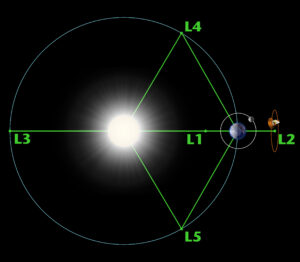 In a system dominated by two attracting bodies (such as the Sun and Earth), a point at which a third, much smaller body (such as a satellite) keeps the same position relative to the other two. This is the Langrangian point.
In a system dominated by two attracting bodies (such as the Sun and Earth), a point at which a third, much smaller body (such as a satellite) keeps the same position relative to the other two. This is the Langrangian point.
Theoretically, the Sun-Earth system has 5 Lagrangian points, but only two are important: L1, on the sunward side of Earth, about 4 times the distance of the Moon, and L2 at approximately the same distance on the midnight side.
The only two Lagrange stable points, L4 and L5, lie in the orbit of the primary body, leading and trailing it by a 60-degree arc. Jupiter’s trojan asteroids can be found orbiting around the Jupiter-Sun L4 and L5 points.
Watch this video for more details: What are Lagrange Points? We Asked a NASA Scientist
Contacting us is easy, simply complete the form below.
Standard delivery ships in 2-4 working days.
Please allow up to 4 weeks for international orders to arrive (we are working very hard to reduce this time).
FREE on all orders over £25.00;
£3.95 for orders under £25.00;